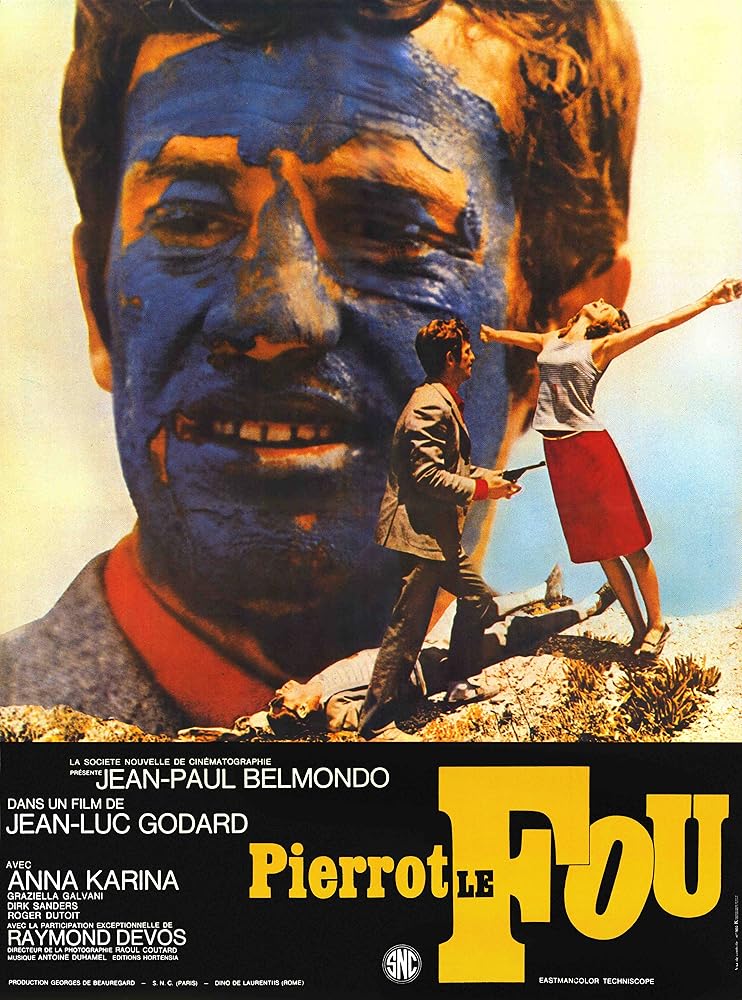
PIERROT LE FOU
(director/writer: Jean-Luc Godard; screenwriter: from the book Obsession by Lionel White; cinematographer: Raoul Coutard; editor: Francoise Collin; music: Antoine Duhamel; cast: Jean-Paul Belmondo (Ferdinand Griffon, “Pierrot”), Anna Karina (Marianne), Dirk Sanders (Fred, Marianne’s Brother), Raymond Devos (Man on the Pier), Graziella Galvani (Ferdinand’s Wife), Laszlo Szabo (Political Exile from Santo Domingo), Samuel Fuller (Himself), Jean-Pierre Léaud (Young Man in Movie Theatre); Runtime: 110; MPAA Rating: NR; producer: Georges de Beauregard; Pathé Contemporary Films; 1965-France-in French with English subtitles)
“Brilliant but disturbing essay on love and a myriad of other things.”
Reviewed by Dennis Schwartz
Jean-Luc Godard (“Breathless”/”Band of Outsiders”) at his peak, presents a brilliant but disturbing essay on love and a myriad of other things. The film seems spontaneously shot on the French Riviera, and was based on the book Obsession by Lionel White. Beautifully filmed by cinematographer Raoul Coutard amid the colorful summer landscape and lush trees. The filmmaker said about this experimental romantic adventure tale “I wanted to tell the story of the last romantic couple.”
Ferdinand Griffon and Marianne (Jean-Paul Belmondo and Anna Karina-the director’s first wife) take to the road as they flee Paris and head for the South of France. This happens after Marianne is coincidentally his baby-sitter for his families’ two children, as it turns out she was romantically involved with him some five years ago when he was single. While driving her home, they decide to run away together in his Peugeot. Ferdinand, who for some unexplained reason is called Pierrot by Marianne, is bored with his wealthy Italian wife (Galvani) and his shallow bourgeois lifestyle. He’s also a bit pissed at Marianne for calling him Pierrot, even when corrected.
On the road, the film turns into many different things from a painting by Velasquez to a musical. But for the most part plays out as an unconventional gangster story, where the duo gets caught up in the intrigue of stealing cars and being involved with gun-runners through Marianne’s brother (Dirk Sanders) and eventually a murder. Marianne is the femme fatale mobster’s moll and betrayer of romantic notions, who leads the cool Sixties rebel Pierrot on with promises of love. Their escapade is built on nonsense and sadness, which leads him to search for answers to life in books and the questioning of the Vietnam War. By the time the couple run the gamut of emotional highs and lows, he in an act of desperation kills her and her gun-runner boyfriend and then paints his face blue and blows himself up with dynamite. It ends with a full view of the magnificently blue Mediterranean sea and a quizzical voice questioning the nature of things by using lines from a Rimbaud poem to ask: “Eternity? No, it’s just the sun and the sea.”
It was fun to see American director Samuel Fuller in a cameo explaining that his next picture is about love and hate.
Pierrot le Fou won the Critics’ Prize at the 1965 Venice Film Festival.
REVIEWED ON 3/3/2004 GRADE: A-